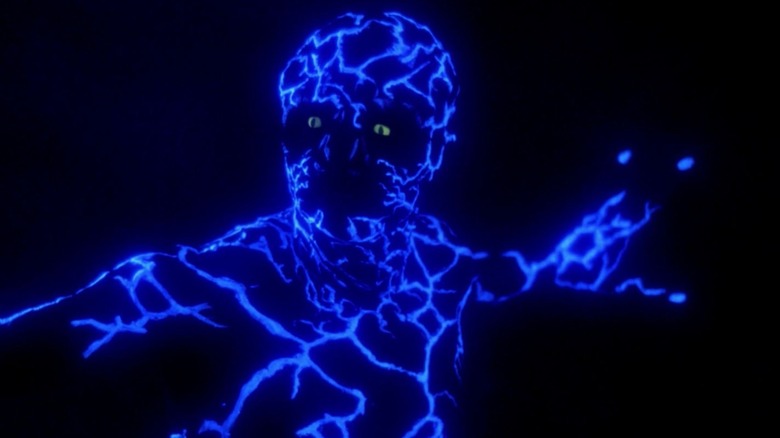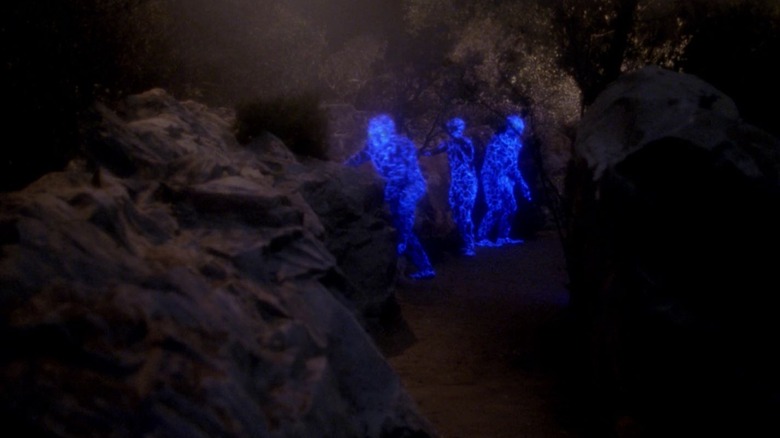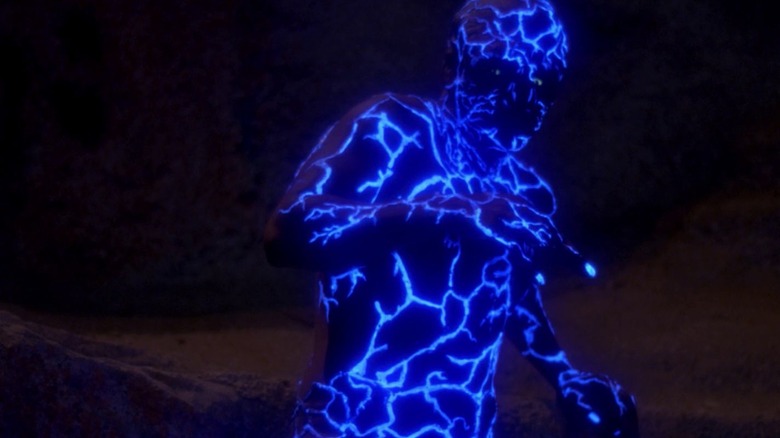How Star Trek Made LeVar Burton Actually Glow For Its Identity Crisis Episode
In the "Star Trek: The Next Generation" episode "Identity Crisis" (March 25, 1991), Lieutenant Commander Geordi La Forge (LeVar Burton) meets an old friend, Lieutenant Commander Susanna Leijten (Maryann Plunkett), the only surviving member of a mission they both went on years before. It seems that their compatriots have gone missing or stolen shuttlecrafts to return to the planet Tarchannen III, where they were last united. Soon after her arrival, Leijten also begins exhibiting weird behavior, twitching nervously and demanding a visit to Tarchannen III. Her body begins to mutate. Her fingers fuse together and eerie blue veins appear on her skin. Her eyes turn yellow. It's all Dr. Crusher (Gates McFadden) can do to slow the mutations.
Geordi, while unattended, also suddenly begins to mutate. He eventually returns to Tarchannen III, having turned into a near-invisible creature that can only be seen under a special blacklight. Leijten has to overcome her own mutations and communicate with Geordi before his transformation becomes irreversible.
"Identity Crisis" is a good body-horror episode of "Star Trek," and perhaps shouldn't be watched in the dark alone. The scene where Geordi recreates a shadow on the holodeck is one of the scariest in the show's history.
In order to achieve the look of the invisible alien, Burton had to undergo a full-body makeup process that involved a facial prosthetic, contact lenses, a lot of painted-on veins, alien gloves, and alien feet. It was the most makeup Burton ever had to wear on "The Next Generation."
In the book "Captains' Logs: The Unauthorized Complete Trek Voyages" edited by Mark A. Altman and Edward Gross, "Crisis" director David Livingston recalled the makeup process in detail, as well as the complex lighting the episode required. Livingston used U/V light on set, a first for the series.
The Mark & Brian Show
Some fun trivia: local KLOS DJs Mark Thompson and Brian Phelps, stars of "The Mark & Brian Show," played two additional aliens in the episode. They had no lines and just lurched past the camera. They also didn't have to undergo the same makeup process that Burton did, wearing full-body stockings and masks instead. The issue was getting the aliens to glow as it said in the script, a problem Livingston presented to his producer, Peter Lauritson. After checking out some test footage, Livingston went to longtime "Trek" makeup artist Michael Westmore and longtime costumer Robert Blackman about achieving the look. Livingston explained:
"We were talking about how we're going to make these guys glow and Peter Lauritson said to me, 'Why don't we try ultraviolet?' [...] I said because we had done a test the year before. I almost dismissed it, but then pulled out the tape and looked at it, and said this stuff is great. [I] went to Michael Westmore and Bob Blackman and said we want to do this, and they designed these suits and we painted them with U/V [paint] and put these contact lenses into this woman's eyes that glowed. [...] LeVar looked fabulous."
The costumes looked great, and they did indeed glow under a blacklight, a phenomenon anyone who has visited a commercial haunted house has likely encountered. The next problem, however, was lighting a set with blacklight-activated aliens on it. It seems that Livingston had to employ a special kind of blue lamp on set to bathe everything in a low, even color. This was in addition to the white lights needed to illuminate the actors. This kind of lighting had never been done on "Next Generation," a show that typically featured clean and even lighting.
The blue beacon
Livingston described the lighting rig as follows:
"We used heavy blue light for the set lighting, and it's different lighting than you see elsewhere because all the source coming from behind the camera is blue light. That's a decision we made and it should look harsh and unrealistic and not well-lit because it's not lit from one single blue source. It's basically a beacon shining out. It looked different than anything else and that was intentional."
It was certainly strange-looking, giving off a ghostly vibe that wasn't used elsewhere in the series. Livingston noted that it worked well before adding that, after 1991, many other photographers and TV-makers started to use a stylized U/V light to create glowing images, notably in music videos. He continued:
"What I was surprised at was how powerful the U/V reflected back, and MTV is using it a lot now. I liked our use because it was integrated into the story. We used it to make it work dramatically rather than doing it as an effect. To me, that was a major accomplishment. We didn't do it to just be glitzy, we did it because it tied in dramatically with the story."
The makeup on Burton took four makeup artists and six full hours to apply. It was not just Burton's most extensive makeup job but the longest application in the history of the series. Luckily for Geordi, he was spared a subplot in the "Crisis" script wherein he and Leijten experienced a stalled romance. Geordi had already experienced several stalled romances, and piling another one on the character seemed cruel. The showrunners merely mutated him into an alien instead.


